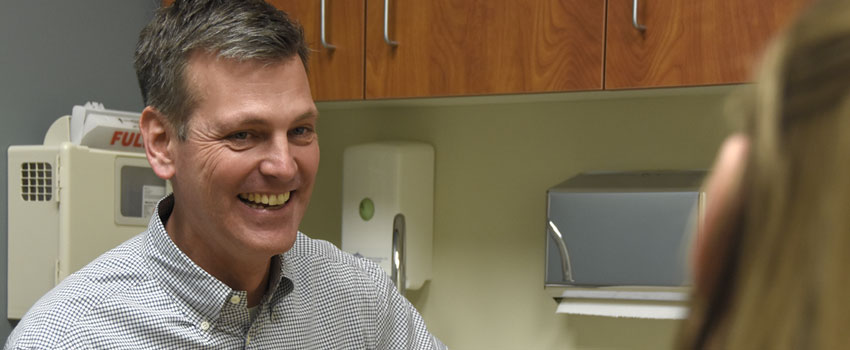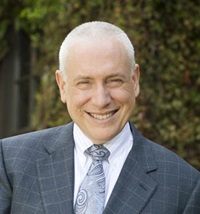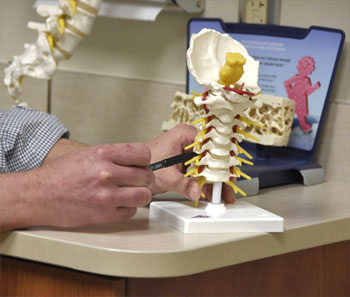Dr. Pate’s Prescription for Change
St. Luke’s Cutting-Edge Work in Patient-Reported Outcomes: It’s the Data that Matters

Neurosurgeon Dr. Ken Little and St. Luke’s colleagues
envision much different care than is currently delivered and are working to
build the information base that can make that care possible.

In previous blog posts, I have focused repeatedly on patient-centered care. Though patient centeredness refers broadly to all the experiences at every touchpoint, at its essence it requires determining the patient’s goals for treatment and then providing value as determined by the patient.
That is exactly what we are focused on at St. Luke’s, and a group of orthopedic surgeons and a neurosurgeon are taking this to the next level, measuring outcomes from the patient’s point of view. Instead of simply measuring mortality and complication rates (both of which our patients expect to be zero in their particular case), we are looking to the patient’s function and well-being weeks to months following a treatment, especially as they relate to the goals the patient had for undergoing the procedure.
Not content to rest with this, St. Luke’s physicians are compiling this data so that in the future, we may be able to input multiple data points about a particular patient and then give them much more precise predictions as to their outcomes with particular treatments.
Here with more about this important initiative is Roya Camp, my blog editor, who has interviewed physician leaders involved in the work.
- David C. Pate, M.D., J.D.
A small group of St. Luke’s physicians and physicians who work with the health system are looking past the healthcare tipping point preoccupying clinicians across the country to a time when predictive analytics and risk stratification will allow for custom medicine.
For several years, surgeons and physicians across multiple specialties and areas of interest have been working to assemble usable data to help St. Luke’s and its staff members better determine how specific patients will do following specific treatments and operations.
It’s a far more difficult challenge than it might appear, largely because health care generally has not performed longitudinal surveys regarding outcomes. And while there is some outcomes data, having to do with some procedures, the myriad ways in which different patients may respond has been nearly impossible for individual physicians to know.
The challenge may not be what it appears. Much is being made of IBM’s Watson supercomputer, which for about five years has been used by a variety of hospitals and health systems tackling some of the thorniest problems in medicine. Named for IBM’s founder, Thomas J. Watson, the powerful computing system combines multiple learning approaches to mine mountains of data and evidence for the best answers to questions.
Artificial intelligence, such as the output of Watson and other sophisticated computer systems, is likely to accelerate clinicians’ understanding of disease states and conditions, but that output will only be as good as the input – including not only physicians’ results, but also the information reported by patients following their procedures and treatments. In the end, Watson and any of its machine learning, or the machine learning from any other system, will only be as good as its input.
Why focus on better data? St. Luke’s Dr. James Beckmann points to the work of Harvard economist Michael E. Porter, author of Redefining Health Care: Creating Value-Based Competition on Results.
In the 2006 book, Porter wrote, “The way to transform health care is to realign competition with value for patients. Value in health care is the health outcome per dollar of cost expended. If all system participants have to compete on value, value will improve dramatically.”
“Good quality is less costly because of more accurate diagnoses, fewer treatment errors, lower complication rates, faster recovery, less invasive treatment, and the minimization of the need for treatment,” Porter observed. “More broadly, better health is less expensive than illness.”
Among the aspects of the challenge that trouble the physicians is variation. There has been significant concern nationwide over the wide swings in the practice of spine surgery, state to state, county to county, hospital to hospital. For Dr. Kevin Shea, that phenomenon alone indicates that patients aren’t getting what they want or need.
“We need to agree on common variation,” he said.
To all these ends – better data, better outcomes, better health – neurosurgeon Dr. Ken Little, orthopedic surgeons Dr. Beckmann and Dr. Shea and others have begun to focus on patient-reported outcomes data as a critical and missing piece of the puzzle.
The physicians know, among other things, that the goals clinicians might set are not necessarily those set by individual patients. Quality might mean something very different, depending upon whether you are performing the operation or having it. Regardless, there’s not much long-term data to be able to determine quality over time, no matter how you define it.
And then there is the not insignificant psychosocial factor. Depression, support structures and a host of other variables are known to influence outcomes but are rarely if ever measured or factored into outcomes. Inferential statistics can only accommodate a limited number of variables, which makes lots of existing data relatively useless, and current measures don’t begin to touch patient perceptions around the results of their procedures, or what happens over time, and are in effect “proxy measures” of how patients fare.
It may be the case that a specific patient would have done just as well with a far less expensive or invasive procedure – or the reverse, that the patient needed something much more complicated. Preferences vary and expectations vary, patient to patient, physician to physician. Quality of life following the operation, separate from the quality of the operation itself, also might be very, very different, from patient to patient or in one physician’s opinion vs. the next.

And good data is likely to point up departures from current thinking and practice; Dr. Shea provides as an example the current understanding with respect to clavicle fractures, where longer-term data now suggests surgery may offer similar outcomes to non-operative treatment in some patient groups. Some patients obviously benefit from surgery, and patient-reported outcome measures will help physicians know who does better with each approach. Engaging patients in the conversation is critical.
“Health care is a failed market, by definition,” Dr. Little said, referencing Porter’s thinking. “No one is collecting the right data. It’s the tyranny of small decisions.”
It sounds counter-intuitive to the principles of evidence-based medicine and standardization, but there’s reason to think that some logical variance is in patients’ best interests – and in the best interest of American health care. In a 2013 report titled “Best Care at Lower Cost: The Path to Continuously Learning Health Care in America,” the Institute of Medicine said that better outcomes and lower costs would be contingent on understanding individual patients’ situations.
By combining a patient’s health history, ideas about health and well-being, known outcomes to a specific procedure and other information, the St. Luke’s physicians hope that they’ll be better able to know in advance how a specific person will fare after leaving the hospital or clinic. They’ll get a closer look at how patients respond over time and how outcomes fare over time, then be able to apply predictive analytics to design the best care for each patient.
It’s clear to them that, in keeping with Porter’s ideas, better care is possible through this predictive approach, care that would support better health, and that better outcomes are likely to translate into lower costs over time.
Gaining ground with better data and the use of better data, they believe, will lead to much more honest conversations with patients around the outcomes they can expect and just what “better health” might mean to them. A patient, for example, may arrive at a physician’s office in better shape than any procedure might promise, and no surgery is going to provide what is being sought. Better data, they reason, will build confidence in both patients and physicians, address both over- and under-utilization of medical procedures as practiced today and truly customize medicine.
“Basically, we want patients making decisions, and patient-reported outcomes will help patients and providers make the best decisions,” Dr. Shea said.
These surgeons, among the best in their fields, who get paid for the surgeries they do, are very aware that better data might well mean fewer surgeries. How would Dr. Beckmann feel about that?
“Great,” he said, going on to explain that because surgery is inherently risky, he wants to make sure every surgery he performs is worth it.
They have begun to collect the data they will need, and are looking first at high-impact, high-cost, high-variation areas, starting with those areas in which they are most versed – spine surgeries and significant joint replacements. Once they have their database, they know it needs to be valid, relevant and easily accessible to physicians and patients for decision-making, on tablet computers if possible.
It’s a daunting prospect. By comparison, surgical site infection reduction, which the physicians also have been involved in, is a relatively straightforward undertaking. Physicians feel pressured now by the demands of their work, and asking them to ask patients to take part in surveys, or for patients to take the time to complete surveys, can be perceived as burdensome. The data is easily biased by sampling error, when clinicians and patients alike are too busy to submit the needed information. Additional detail is lost when follow-up falls through, clinicians or patients move or appointments are discontinued. And it’s a numbers game; there need to be significant numbers of patients, fundamentally, for any data to be meaningful.
The effort, the physicians observe, is somewhat more manageable within St. Luke’s than it might be in many other healthcare systems. They estimate it will take three to five years to have what they want to begin.
“St. Luke’s supports innovation,” Dr. Little said, adding that the organization’s emphasis on quality underscores a commitment to improvement that lends credence to the data effort.
The organization and leadership have encouraged out-of-the-box thinking, they note, and caseloads are such that progress on larger needs and issues in health care can be achieved. Based on their discussions with colleagues, they believe that they – and St. Luke’s – are ahead of others in the thinking and the effort.
“This is a very inspiring organization,” Dr. Shea said. “I’m so excited about where we’re going in health care.”
About The Author

Roya Camp works in the St. Luke’s Communications department.



